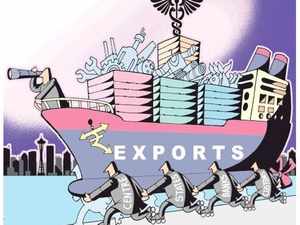
As an immediate measure to protect exports, CII has suggested that exports be classified under essential services so that they can operate with free movement of cargo across states

COVID-19 CASES
WorldIndiaConfirmed9,152Deaths308Confirmed1,846,680Deaths114,090By Chandrajit Banerjee
The global spread of Covid-19 has brought about an unprecedented halt to activity in all major economies. WTO has forecast global trade volumes to drop sharply by 13-32 per cent, which has not been seen before in the modern era. The situation is so fluid that most of us hesitate to put a number to growth projections for 2020-21.
Companies dependent on foreign trade are especially vulnerable in these times. India’s biggest export markets – the EU and US – have extended lockdowns in place. Already, between April 2019-February 2020 for the period before the lockdown, India’s merchandise exports declined by 1.5 per cent over the same period last year while imports declined by 7.3 per cent to $436.03 billion.
As the world battles Covid-19, we must take care to sustain our export markets and ensure that lockdown does not translate into loss of outward bound goods. As a first step, the government has provided a welcome extension of the foreign trade policy incentives which were to expire on April 1.
As an immediate measure to protect exports, CII has suggested that exports be classified under essential services so that they can operate with free movement of cargo across states. Delays in filing of bills of entry and payment of customs duties should be given a onetime relaxation of three to six months.
A key issue facing exporters is credit access. The extension of the interest subvention scheme available for MSME exporters could be announced immediately. Further, to tide over the current crisis situation, the scheme could be extended to all exporters as well as those manufacturing mainly for exports. For imports related to exports, banks need to prioritise credit documents and provide special cash credit funding.
Most nations are proactively supporting their exporters during these difficult times. For example, China increased export refund facility by 2 per cent recently. Such moves make Indian goods less competitive in global markets and must be compensated through an additional duty drawback of at least 3 per cent for the next six months to avert mass closure of enterprises.
Another challenge for exporters due to the current lockdown measures is delays in clearances of import containers which attract increase in demurrage and container freight station charges. Such charges should be waived to avoid cost escalation, along with relaxation in time for submission of documents. Some facilities, such as exports inspection council which provides certificates of origin, need to continue operations to avoid delays in exports.
Certain ports and airports should be specifically identified for handlin g exports on priority basis. To ensure that goods reach these exit points, selfcertification should be considered as valid for inter-state movement.
Clearly, the current geographic configuration and concentration of global value chains will dramatically reorient due to the pandemic. The sourcing and import disruptions that have occurred as a result of Covid-19 mean that countries will be seeking to diversify their markets and sources of imports. This will also need to be taken up multilaterally.
India stands a good chance to be able to leverage the evolving trend if it makes strong efforts to expand its export basket and reduce domestic logistics and procedural costs. To diversify exports, agricultural products present a good opportunity. The agriculture ministry has identified 21 products which could be prioritised.
Targeting a few countries per product and meeting their specific standards and sanitary and phytosanitary import requirements also needs attention – this can be done through a government industry standards taskforce. Given air travel disruptions, the government could consider instituting special flights with appropriate sanitary and disinfectant provisions to enable exports from the horticulture, floriculture and processed food sectors.
Two, meat, poultry and fisheries sector could see enhanced exports as well. Trade facilitation by simplifying farm registration procedures for greater traceability and making antibiotic testing easier is required. Easy access to cold storage and warehousing facilities in marine or other food parks at concessionary rates would also be helpful, as would greater avenues to enable processing and value addition.
Three, India has been called the ‘world’s pharmacy’ because of the dominance and quality of its generic medicines. Its supply of drugs to fight Covid-19 to the US and Brazil was a welcome move as it strengthened the India brand as a reliable source of pharma products.
The government has announced an incentive programme of Rs 10,000 crore for spurring domestic API production and in the short term, imports of API could also be considered for ramping up manufacturing for domestic use and exports. Alternative sources of APIs such as Japan, Canada, the Netherlands should especially be explored. Indian pharmaceutical and biotech firms could also look at collaboration with global peers seeking to roll out the new Covid-19 vaccine and treatment medications. For both clinical trials and quality manufacturing, India could position itself as the ideal partner.
Over the medium term, global trade governance will emerge as a critical area for the world to work on in order to minimise disruptions and coordinate actions. This can only be done collectively and strengthening the WTO would be the best mechanism to achieve this.
Indian industry remains fully committed to working with the government to navigate these uncertain times and begin the process of realising India’s full potential in trade.
(The writer is Director General, Confederation of Indian Industry, CII)
Source: indiatimes.com

